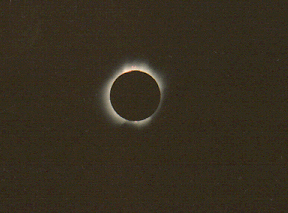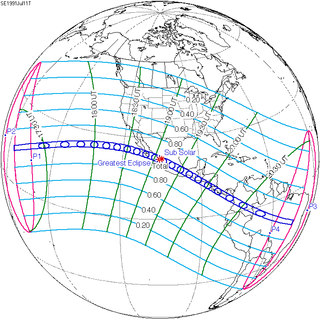Solar eclipse of July 11, 1991
| Solar eclipse of July 11, 1991 | |
|---|---|
 Totality from Playas del Coco, Costa Rica | |
| Type of eclipse | |
| Nature | Total |
| Gamma | −0.0041 |
| Magnitude | 1.08 |
| Maximum eclipse | |
| Duration | 413 s (6 min 53 s) |
| Coordinates | 22°00′N 105°12′W / 22°N 105.2°W |
| Max. width of band | 258 km (160 mi) |
| Times (UTC) | |
| (P1) Partial begin | 16:28:46 |
| (U1) Total begin | 17:21:41 |
| Greatest eclipse | 19:07:01 |
| (U4) Total end | 20:50:28 |
| (P4) Partial end | 21:43:24 |
| References | |
| Saros | 136 (36 of 71) |
| Catalog # (SE5000) | 9489 |
A total solar eclipse occurred at the Moon’s descending node of the orbit on Thursday, July 11, 1991. A solar eclipse occurs when the Moon passes between Earth and the Sun, thereby totally or partly obscuring the image of the Sun for a viewer on Earth. A total solar eclipse occurs when the Moon's apparent diameter is larger than the Sun's, blocking all direct sunlight, turning day into darkness. Totality occurs in a narrow path across Earth's surface, with the partial solar eclipse visible over a surrounding region thousands of kilometres wide. Totality began over the Pacific Ocean and Hawaii moving across Mexico, down through Central America and across South America ending over Brazil. It lasted for 6 minutes and 53.08 seconds at the point of maximum eclipse. There will not be a longer total eclipse until June 13, 2132. This was the largest total solar eclipse of Solar Saros series 136, because eclipse magnitude was 1.07997.
This eclipse was the most central total eclipse in 800 years, with a gamma of -.0041. There will not be a more central eclipse for another 800 years. Its magnitude was also greater than any eclipse since the 6th century.
Observations[edit]
- Animation of eclipse path
- Partial phase before totality as seen through the cloud cover, Playas del Coco, Guanacaste, Costa Rica
Related eclipses[edit]
Eclipses of 1991[edit]
- An annular solar eclipse on January 15.
- A penumbral lunar eclipse on January 30.
- A penumbral lunar eclipse on June 27.
- A total solar eclipse on July 11.
- A penumbral lunar eclipse on July 26.
- A partial lunar eclipse on December 21.
Alleged prediction[edit]
The American ethnographer and anthropologist Victoria Bricker and her late husband and colleague Harvey Bricker, claim in their book "Astronomy in the Maya Codices" that by decoding pre-Columbian glyphs from the four Maya codices they discovered that pre-16th century Mayan astronomers predicted the solar eclipse of July 11, 1991.[1] In their 2011 volume, the husband-wife Brickers team explain how they translated the dates from the Mayan calendar, then used modern scientific knowledge of planetary orbits to line up the data from the Mayan prediction with our calendar.[2] Reviewers disputed the claim in 2014, concluding that, "loose hieroglyphic readings and accommodating pattern matching occurs throughout the book."[3]
Notes[edit]
- ^ Solar System, Exploration. "Eclipses". solarsystem.nasa.gov. Nasa. Retrieved December 21, 2022.
- ^ Kramer, Miriam (January 8, 2013). "Ancient Maya Predicted 1991 Solar Eclipse". Live Science. Retrieved April 13, 2023.
- ^ Gerardo Aldana (March 2014). "ISIS: An International Review Devoted to the History of Science and to Cultural Influences". The University of Chicago Press Journals. 105 (1). doi:10.1086/676751. JSTOR 10.1086/676751. Retrieved 21 April 2024.
References[edit]
- NASA graphics
- Observer's handbook 1991, Editor Roy L. Bishop, The Royal Astronomical Society of Canada (p. 101)
Photos:
- Russian scientist observed eclipse
- Russia expedition
- Baja California, La Paz. Prof. Druckmüller's eclipse photography site
- Baja California, Todos Santos. Prof. Druckmüller's eclipse photography site
- Reyna from La Paz, Baja California, Mexico
- www.noao.edu: Satellite view of eclipse
- [1] APOD 7/16/1999, Solar Surfin', total eclipse corona, from Mauna Kea, Hawaii
- [2] APOD 10/24/1995, A Total Solar Eclipse, total eclipse corona
- The 1991 Eclipse in Mexico
Videos:
- Total Solar Eclipse -- July 11, 1991 (9:39 uncut, eclipse full frame, location insert)
- Total Solar Eclipse (8:23 edited, includes pre-planning and post-press, music only)
- Total Solar Eclipse, Cabo Mexico (9:12 edited, includes some TV news coverage)


 French
French Deutsch
Deutsch





